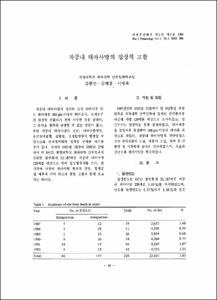KUMEL Repository
1. Journal Papers (연구논문)
1. School of Medicine (의과대학)
Dept. of Obstetrics & Gynecology (산부인과학)
자궁내 태아사망의 임상적 고찰
- Keimyung Author(s)
- Kim, Jong In; Kim, Taek Hoon; Suh, Young Wook
- Department
- Dept. of Obstetrics & Gynecology (산부인과학)
- Journal Title
- 대한주산의학회잡지
- Issued Date
- 1994
- Volume
- 5
- Issue
- 1
- Abstract
- The fetal death in utero is defined as the intrauterine death of a fetus after 20 weeks gestation or attainment of 500gm body weight prior to the complete expulsion or extraction from it is mother. This is a clinical study of 245 cases of the fetal death in utero among 6658 deliveries at Dongsan Medical Center, Keimyung University during 3 years from January 1981 to December, 1983. The results of this study were as follows: 1. The incidence of the fetal death in utero was 3.68%. 2. The age distribution of mothers with the fetal death in utero was 17~42 years and was highest in the 26~30 years range(45.7%). 3. The parity of mothers in the fetal death in utero was the most highest in the nulliparous group (52.2%), and the next group was para-1 (27.4%). 4. There were 23 cases (9.4%) with the previous history of the fetal death in utero and 46 cases (18.8%) with the previous history of the spontaneous abortion. 5. The most subjective sign of the fetal death in utero was no quickening (89.0%) and the others were breast change (5.7%), and abdominal change (5.3%). The final diagnosis of the fetal death in utero was performed by U.S.G. 6. The most common gestational weeks when the fetal death in utero was detected, was 33~36 weeks gestational period (24.1%), and the most common presention was cephalic (67.3%). The sex ratio of male vs female fetus was 1.23:1, and the cases of the fetal death in utero weighting less than 2500gm were 171 cases (70.3%). 7. The hematologic findings of the fetal death in utero showed positive F.D.P. (10.6%), a lower serum fibrinogen less than 200mg (7.8%). 8. The mode of the delivery for the fetal death in utero showed that the induction of labor was most comon (69.0%), and the spontaneous delivery was 26.9%, the laparotomy was 4.1%. 9. The etiologic factors of the fetal death in utero: unexplained causes (43.7%), preeclampsia (15.1%), cord problem (12.7%), congenital anomaly (7.8%), abruptio placenta (6.1%), syphilis (4.5%), chorioamnionitis (2.5%), trauma (2.0%), maternal chronic disease (2.0%), uterine rupture (1.6%), placenta previa (1.2%) uterine anomaly (0.8%). 10. There were 81 cases (33.1%) of the maternal complication. The most common complication was hemorrhage (38.3%), and the others were cervical laceration (19.8%), intra-and postpartum fever (18.5%), U.T.I. (13.6%), uterine rupture (4.9%), postpartum cardiomyopathy (2.5%), wound infection and septicemia (1.2%) respectively. 11. The 23.2% of the cases had not received any prental care, 32.7% was 1 or 2 times prental care, 27.8% was 3 or 4 times, 16.3% was 5 times over.
- Alternative Title
- Clinical Study for Fetal Death in Utero
- Publisher
- School of Medicine
- Citation
- 김종인 et al. (1994). 자궁내 태아사망의 임상적 고찰. 대한주산의학회잡지, 5(1), 45–53.
- Type
- Article
- ISSN
- 1229-2605
- Appears in Collections:
- 1. School of Medicine (의과대학) > Dept. of Obstetrics & Gynecology (산부인과학)
- 파일 목록
-
-
Download
 oak-bbb-1576.pdf
기타 데이터 / 1.69 MB / Adobe PDF
oak-bbb-1576.pdf
기타 데이터 / 1.69 MB / Adobe PDF
-
Items in Repository are protected by copyright, with all rights reserved, unless otherwise indicated.